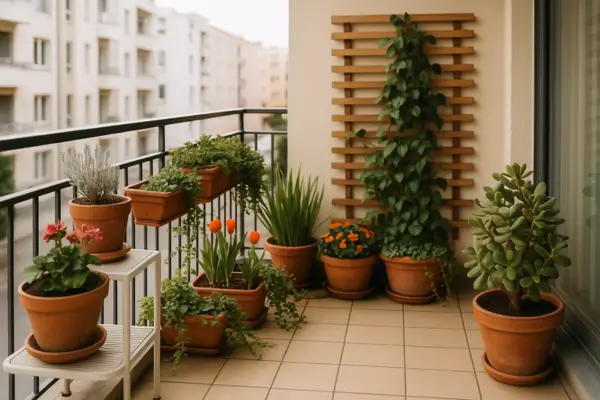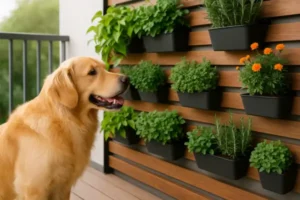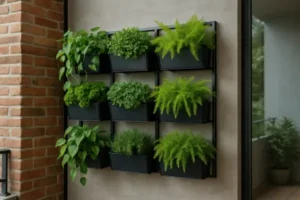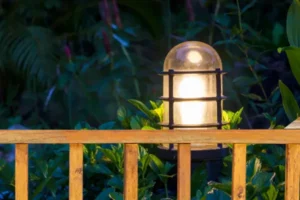The things people forget about when growing plants on their balconies are often the small details—the ones you only notice over time. At first, it’s exciting to arrange your pots and enjoy the greenery. But a balcony works differently, and plants react in ways you might not expect.
Sunlight changes more quickly. Wind can surprise you. Heat builds up on the ground, and rain escapes more than it falls. These small differences affect how each plant establishes itself, how water behaves, and how routines need to adjust.
We’ll cover nine little things that often go unnoticed but really shape the growth of plants on balconies. Knowing them ahead of time makes everything go more smoothly and helps you create a space that works better day after day.
Not Checking How Sunlight Moves During the Day
One of the things people forget when growing plants on balconies is how different sunlight behaves in small spaces. A plant that looks perfect at 9 a.m. may be in full shade by noon—or overheating by 3 p.m. Each balcony has its own light pattern, and it doesn’t always match what’s written on plant tags.
It helps to take a few days before setting up anything permanent. Notice how long direct light hits the space, which corners stay brighter, and where the sun moves. This makes a big difference when choosing what to plant—and where to place it.
Some balconies only get morning light, which is softer and better for herbs or leafy greens. Others face west and receive stronger sun in the afternoon, which works for certain succulents or flowering varieties.
Light also bounces off nearby buildings, glass, and even light-colored walls, adding unexpected heat or glare.
Taking time to understand the light pattern allows your plants to grow better and helps avoid weak stems, burnt leaves, or dry soil patches. It’s a simple habit that sets up everything else with more balance.
Forgetting About Airflow and Wind Patterns
One of the things people forget when growing plants on balconies is how much airflow matters. Unlike open gardens, balconies often create their own wind tunnels.
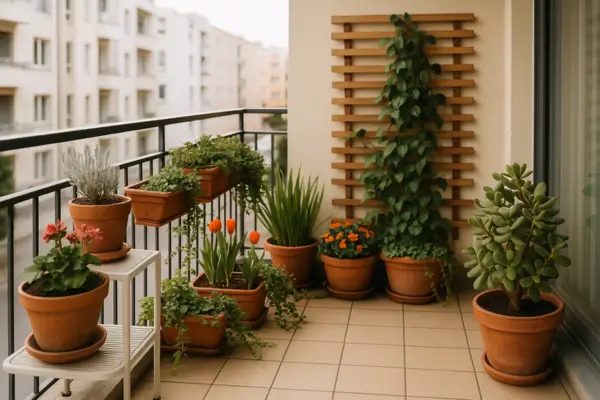
Air can rush through narrow gaps, build up around corners, or shift suddenly with the weather. It’s something you only notice after a few tipped pots or damaged leaves.
This can change how plants grow, how they hold moisture, and how they handle daily sun exposure. Some species dry out faster when there’s too much air movement.
Others can develop weak stems if the wind always pushes in one direction. Paying attention to how the air flows gives you more control over where and how your plants should be placed.
How to Read the Wind on Your Balcony
Before setting up a full arrangement, take a few days to observe the space. Open the door at different times—morning, afternoon, and just before dark. You can hang a light ribbon or a strip of paper near the railing to see how the air flows. No need to overthink it—just look for patterns.
If the wind is strong, try placing taller pots or dense plants like bamboo or lemongrass as a barrier. If the air feels too still, leave space between your containers to help circulation. Good airflow helps leaves dry faster after watering and supports strong, balanced growth over time.
Using the Wrong Type of Containers
Among the things people forget when growing plants on balconies, the choice of container often seems minor—but it makes a big difference. The wrong pot can hold too much water, heat up too fast, or tip over when the wind shifts. And when space is limited, every container matters.
Plastic pots are lightweight and affordable, but they can overheat under direct sun. Clay pots breathe well and help prevent soggy roots, but they dry out faster and are heavier to move. Each material behaves differently on a balcony, especially with concrete or tile floors that trap heat.
Choosing the right type of container means matching it with the plant’s needs and the balcony’s conditions. It also means thinking about weight, drainage, and how easy it is to reach for watering or trimming.
What to Look for in Balcony Pots
- Drainage holes are a must. Without them, roots sit in water and may struggle to grow. Add a saucer underneath if needed, but avoid sealing the bottom.
- Wide bases offer more stability. Narrow pots fall easily, especially on windy balconies or railings. Go for lower, broader shapes for better balance.
- Consider double-potting. Place a plastic grower pot inside a decorative one. It makes watering easier and protects the main pot from heat buildup.
It’s also helpful to raise some containers slightly using bricks, trays, or wooden slats. This keeps airflow underneath and helps avoid water stains on the floor. Small changes like these create a more balanced, easy-to-manage setup—especially when the balcony becomes part of your daily routine.
Forgetting to Plan for Drainage
One of the most common things people forget when growing plants on balconies is how the water drains. Indoors, we’re used to pots with trays. Outside, things shift—especially when you’re working over tile, wood, or even someone else’s balcony.
Good drainage is more than a hole at the bottom of the pot. It affects how the soil behaves, how the roots stay healthy, and how clean the balcony remains. Without a plan, you might end up with puddles, stains, or even root rot in your healthiest plants.
Drainage doesn’t need to be complicated, but it does need a little attention from the start.
Simple Ways to Handle Drainage on a Balcony
- Use trays with space: Trays shouldn’t sit flush against the bottom of the pot. A bit of air below helps the water dry out faster and keeps things from going soggy.
- Lift the pots slightly: A small tile, brick, or stand under the pot lets water escape without leaving marks. It also helps prevent mold from forming under heavy containers.
- Choose fast-draining soil: Regular garden soil can get dense in pots. Use a mix made for containers, with added perlite or small bark to help water move freely.
Every balcony is different. Some have built-in drains, others don’t. That’s why a flexible approach works best. Try different placements, monitor how the water behaves after each watering, and adjust as needed. Once it’s set, everything becomes easier—from plant health to cleanup.
Ignoring the Heat That Comes From the Floor
One of the things people forget when growing plants on balconies is how much heat comes from below. Balcony floors—especially those made of tile, stone, or concrete—absorb and hold heat throughout the day.
By late afternoon, that surface can be warmer than the air, and it can affect your plants more than you expect.
The pots that sit directly on the ground get hit from both sides: sunlight from above and warmth from below. This can dry the soil faster and even stress the roots, especially in small containers. Some plants start wilting even when watered, and the reason isn’t always obvious—it’s the floor.
Being aware of this heat buildup helps you position your plants better and avoid problems before they show up.
How to Protect Plants from Floor Heat
- Lift the pots slightly. Even a one-inch gap between the pot and the floor helps air circulate and reduces heat transfer. Small stands or leftover wood pieces work well.
- Use a mat or rug under groups of plants. Natural fiber rugs, wood panels, or rubber mats can block some of the heat and protect delicate containers from direct contact.
- Choose light-colored containers. Dark pots absorb more heat. A lighter tone reflects more sun and keeps the roots cooler—especially during the hottest hours.
It’s a small detail, but it changes how long your plants stay healthy between waterings. It also makes your balcony more pleasant to walk on, especially if you like to move around barefoot or sit close to your plants.
Placing Plants Where They’re Hard to Reach
A surprising one among the things people forget when growing plants on balconies is how reachable each plant should be. In the excitement of arranging everything beautifully, it’s easy to place pots in corners or up high—only to realize later that watering, pruning, or rotating them is uncomfortable.
Plants that are out of reach tend to get ignored. Not because you want to, but because it takes extra effort to care for them. Over time, they dry out faster, get fewer checks for pests, and become harder to manage. On a balcony, where space is limited, accessibility is part of good design.
If you enjoy taking care of your plants, make sure they fit naturally into your routine—not just your layout.
Tips to Make Plant Care Easier
- Group plants by how often you tend to them. Keep the ones you water daily closer to where you stand or sit. Less frequent ones can go farther out.
- Use levels with purpose. Shelves are great, but avoid the top row if you need a step stool to reach it. Lower areas work better for heavier pots that you may want to move.
- Rotate based on the light—and comfort. As the seasons change, move plants as needed, but always place them where your hand naturally goes.
Making care easy means you’re more likely to enjoy the time you spend with your plants. The more natural the setup feels, the more consistent your routine becomes—and the healthier everything grows.
Watering the Same Way All Year Round
Another one of the things people forget when growing plants on balconies is how much the seasons affect watering. It’s easy to fall into a pattern—same amount, same time of day—but outdoor plants don’t behave the same way from month to month.
On balconies, small changes in temperature or sunlight can shift how fast water evaporates or drains.
In cooler months, the soil stays wet longer. In hotter months, it dries fast—especially with wind, direct sun, or heat rising from the floor. Sticking to a fixed schedule without adjusting to these changes can lead to soggy roots or dry pots, even when the plants look fine on the surface.
How to Adjust Watering Over Time
- Check the soil, not the clock. Use your finger to feel one inch below the surface. If it’s still damp, wait a bit. If it’s dry, go ahead and water.
- Watch for faster drying in hot weeks. During a heatwave, even drought-tolerant plants may need more attention. Lighter pots dry out the fastest.
- Water earlier or later in the day. Mornings are ideal in summer. Evenings can work too, but avoid splashing leaves too close to nightfall to keep moisture balanced.
Plants respond to rhythm, not routine. Paying attention to how the conditions shift around your balcony gives you a more accurate sense of what each plant needs—and when.
Forgetting to Feed the Plants Regularly
One of the quiet things people forget when growing plants on balconies is that potted plants rely entirely on us for nutrients. In the ground, roots can search for minerals. On a balcony, inside a container, the soil eventually runs out of what the plant needs—even if everything looks fine.
Water keeps a plant alive, but regular feeding helps it grow stronger, bloom better, and stay more resistant over time. Balcony setups often use light, well-draining soil, which is great for roots but doesn’t hold nutrients for long. That’s why even healthy-looking plants may stall or lose color without warning.
Feeding doesn’t need to be complicated. It’s about small, consistent help over time.
How to Keep Plants Nourished in Balcony Setups
- Use a slow-release fertilizer at the start of each season. These small pellets break down gradually and keep feeding the plant without extra steps.
- Complement with liquid feed during active growth. Every few weeks, mix a gentle liquid fertilizer into your watering routine—especially for flowering or fruiting plants.
- Watch the leaves. If they start turning pale, or growth slows down, it might be time for a nutrient boost.
Balcony plants give a lot back when fed regularly. A small amount of care goes a long way—and the routine becomes simple once it’s part of your rhythm.
Not Giving Plants Time to Settle Before Rearranging
Among the things people forget when growing plants on balconies, moving them around too often is more common than it seems. After planting, it’s tempting to keep adjusting the layout—chasing light, changing looks, or finding the “perfect” position. But every time a plant is moved, it needs to readapt.
Even small shifts in direction, airflow, or light exposure can stress the roots or slow down new growth. When a plant is placed in a new spot, it starts rebalancing how it breathes, drinks, and stretches toward the sun. That process takes time—and frequent changes can interrupt it.
Leaving the plant in place for a little while helps it build strength and stability.
How to Let Your Plants Settle in Peace
- Give them at least 2 to 3 weeks in a new spot. This helps roots adapt to the light and water patterns without added pressure.
- Observe quietly instead of reacting fast. A leaf may yellow or a stem may lean—that doesn’t mean it’s failing. The plant is adjusting.
- Adjust slowly, not all at once. If you really need to move things, do it gradually. A few inches at a time can be enough to test a new position.
Plants on balconies already deal with changing weather, reflected heat, and limited space. Giving them a steady position, even for a short while, helps them settle in and grow with more balance.
Conclusion
There are many things people forget when growing plants on balconies, and most of them are small. But once you start noticing these details, everything flows better. The plants stay healthier, the space feels more welcoming, and the routine becomes easier.
What really helps is paying attention to how your space behaves each day. Light changes, air moves differently, and the floor can hold more heat than expected. Each small adjustment makes your setup work more naturally over time.
In the end, a good balcony garden grows with you. It becomes part of your rhythm, part of how you start or end the day. And when it fits into your life like that, the space quietly becomes one of your favorite places.

